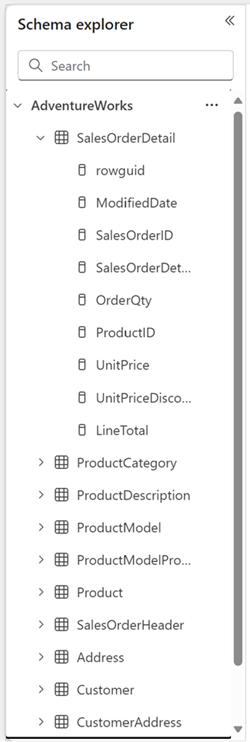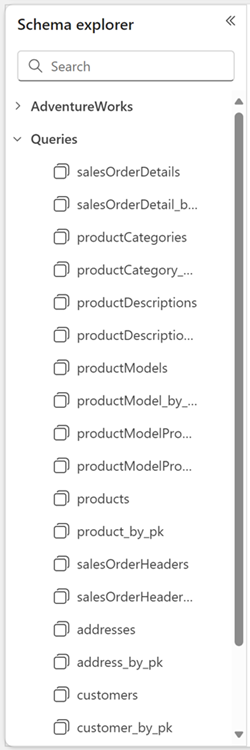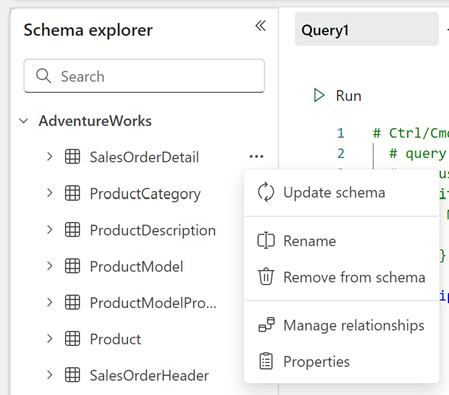Fabric API for GraphQL schema view and Schema explorer
The GraphQL schema, which is based on the GraphQL Schema Definition Language (SDL), defines the format of the data exposed in the API. It's an abstraction layer that provides flexibility to consumers while hiding backend implementation details. The schema is based on a collection of object types that contain fields.
Schema view
You can access the schema view by selecting Schema in the lower left corner of the Data Development screen. The view shows a text-based version of the GraphQL SDL with generated types, fields, and operations.
The following image is an example of the schema view, including an extensive list of objects available in this schema.
Note
The schema view is read-only. You can only modify objects in the Schema explorer.
Schema explorer
The Schema explorer is located in the pane on the left, and is also available when you use the editor in the query view. The explorer allows users to quickly visualize the available types and fields, as well as queries and mutations, defined in the API.
All the GraphQL types that are available from the objects you choose when you connect to a data source appear in the Schema explorer list. The types appear under the name of the data source from which they were derived. In the following image, you see the SalesOrderDetail type derived from the SalesOrderDetail table in the AdventureWorks SQL analytics endpoint.

In addition to types, the Fabric API for GraphQL automatically generates queries and mutations for any new objects you choose to expose.
In our AdventureWorks example, expanding the list of queries shows the automatically generated queries for the data source.

To see the mutations automatically generated by the API, expand the mutations node in the Schema explorer tree.

Modify objects using the Schema explorer
You can use the Schema explorer to modify objects after the API creates them for you. In the following example, we select the ellipsis next to the SalesOrderDetail type derived from our AdventureWorks database:

The following options are available for Types:
- Update schema - Allows you to update the schema with new objects from the data source.
- Rename - Changes the name of the object. PLEASE NOTE: This change only affects the API schema, and has no effect on the original data source object from which it was derived.
- Remove from schema - Effectively deletes the object from the GraphQL schema so you can no longer reference it.
- Manage relationships - Takes you to the relationship management experience. For more information, see Manage relationships in Fabric API for GraphQL.
- Properties - Shows additional information about the object.
Enable and disable queries and mutations
The enable/disable feature for queries and mutations provides administrators and developers with granular control over API access and usage. It allows you to selectively activate or deactivate specific queries and mutations within the GraphQL schema. This lets you manage API capabilities dynamically without modifying code or deploying changes.
Queries and mutations in the schema explorer have two additional options:
- Disable - Prevents any requests from executing the query or mutation. If execution is attempted, an error is returned. Once a query or a mutation is disabled, a schema reload occurs, and the query or mutation appears grayed out in the schema explorer.

- Enable - Re-enable a previously disabled query or mutation. Execution of the item is immediately available upon schema reload operation that takes place after selecting the Enable option.

Please note that queries or mutations auto generated from stored procedures can only be deleted. Once deleted, they can be re-added using the Get Data or the Update Schema options.
